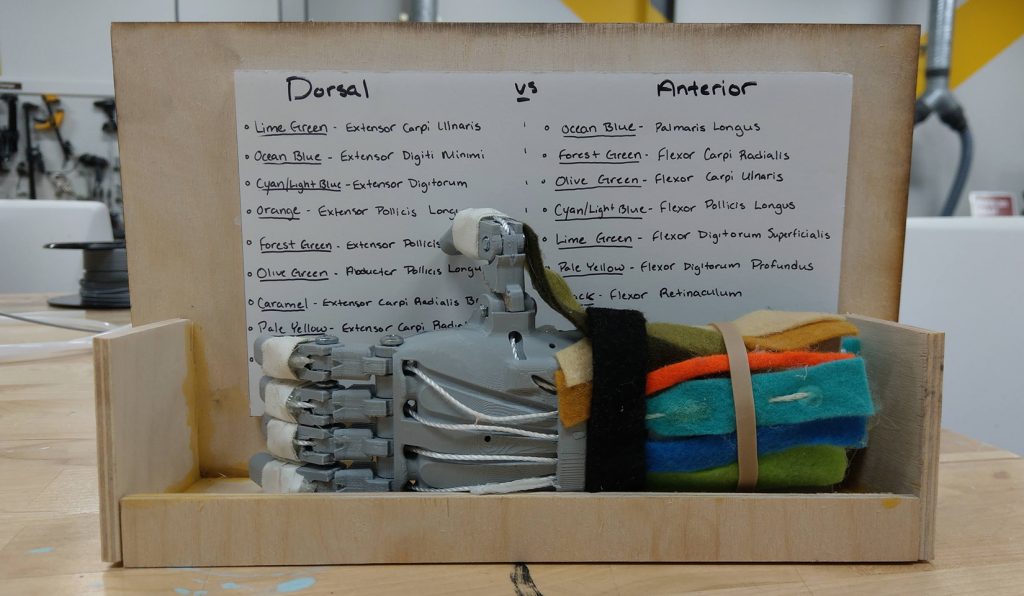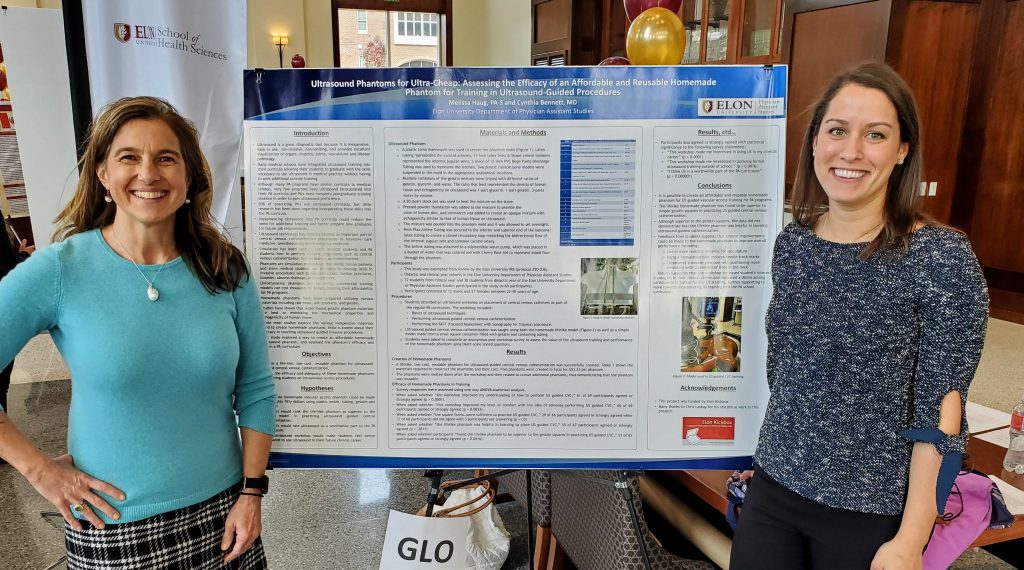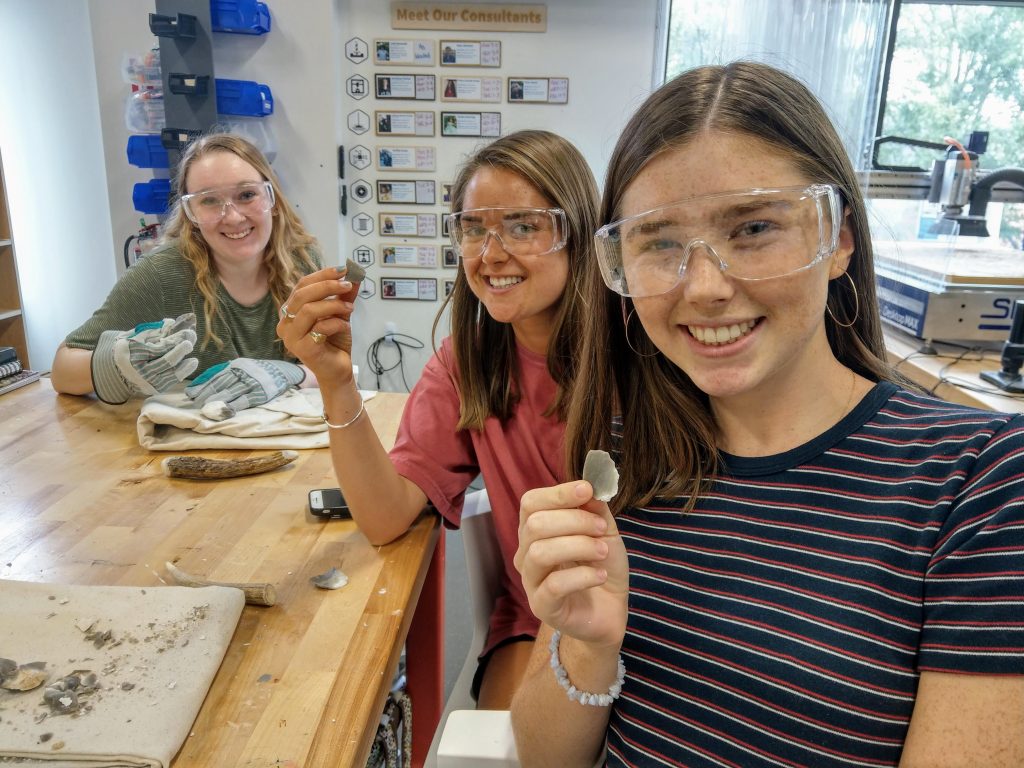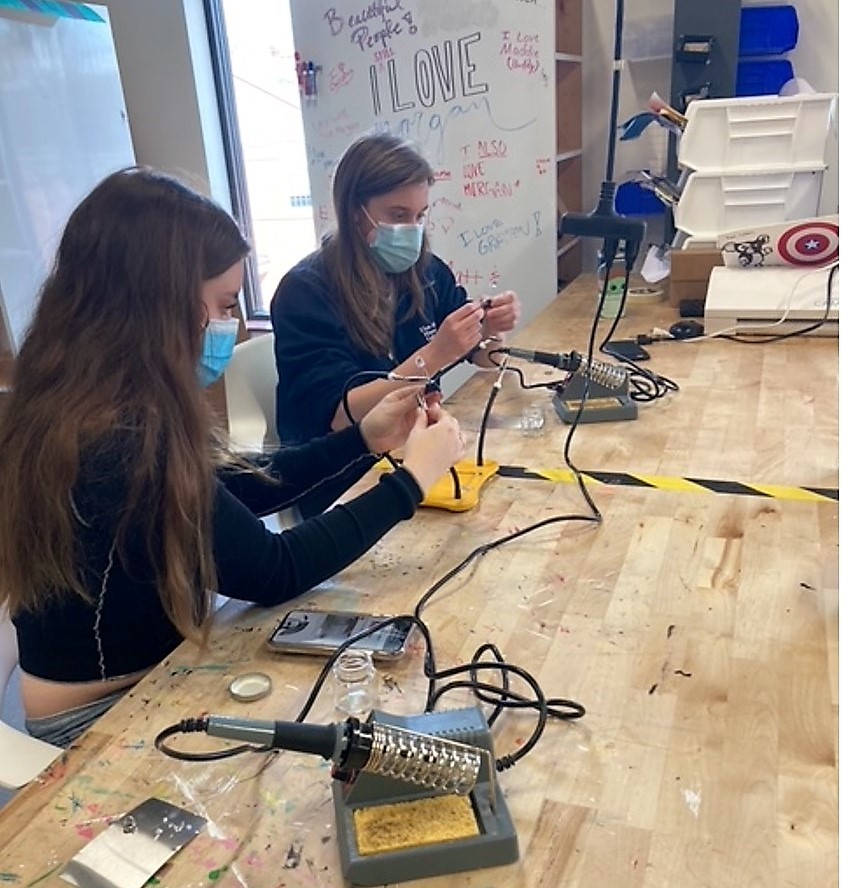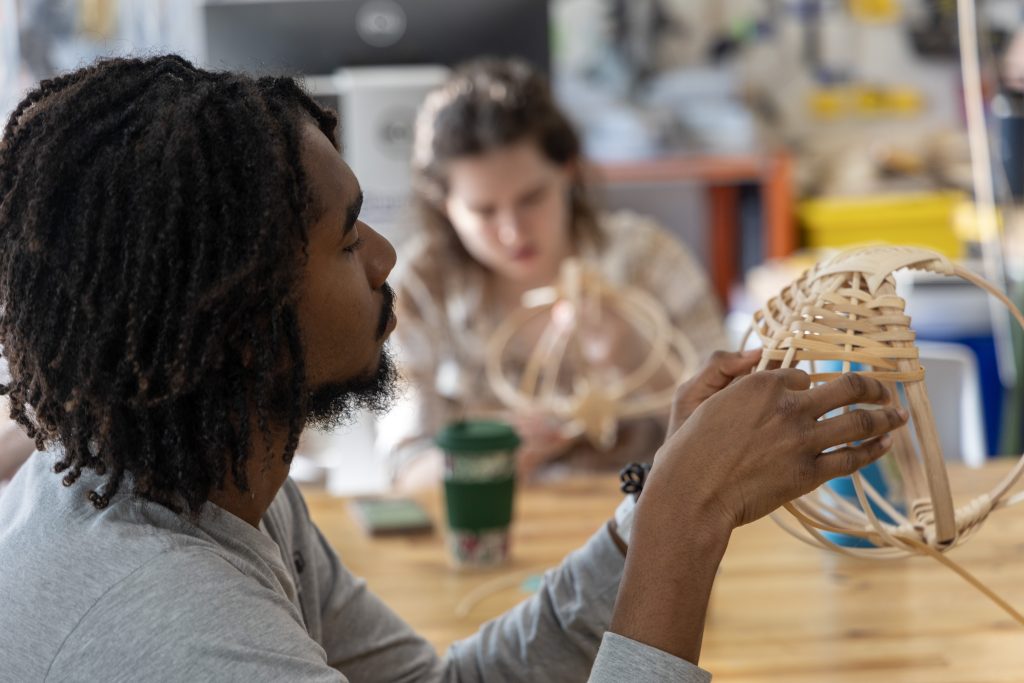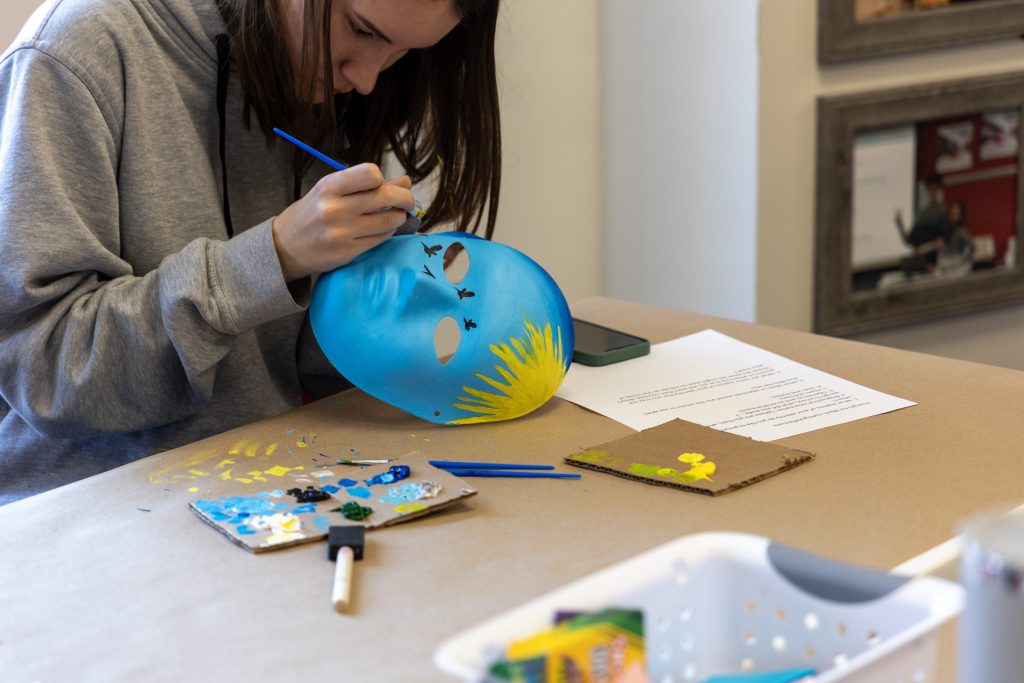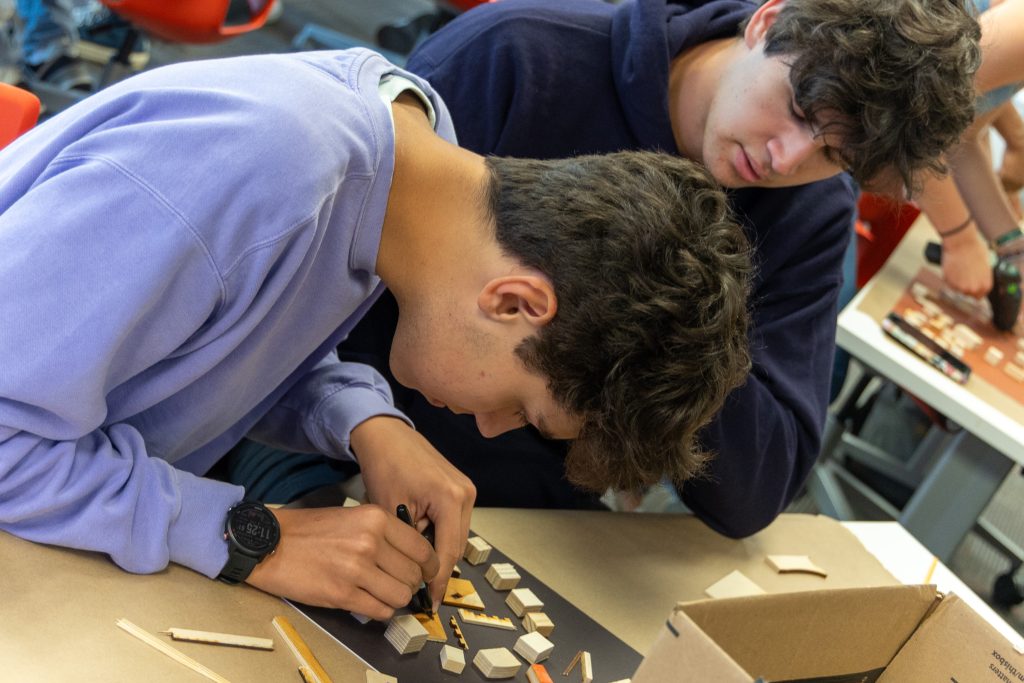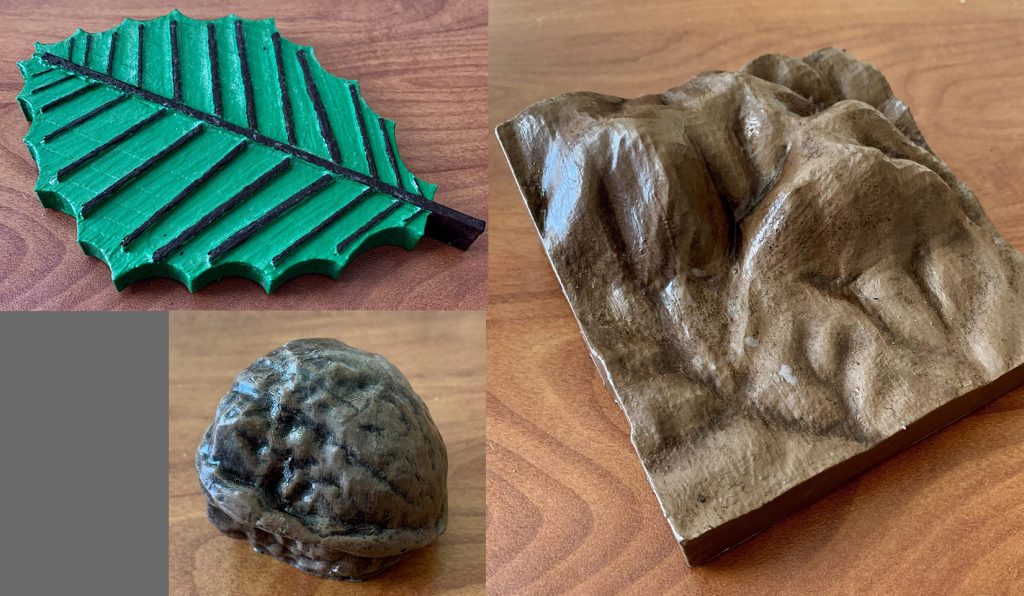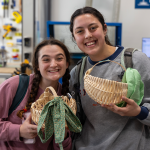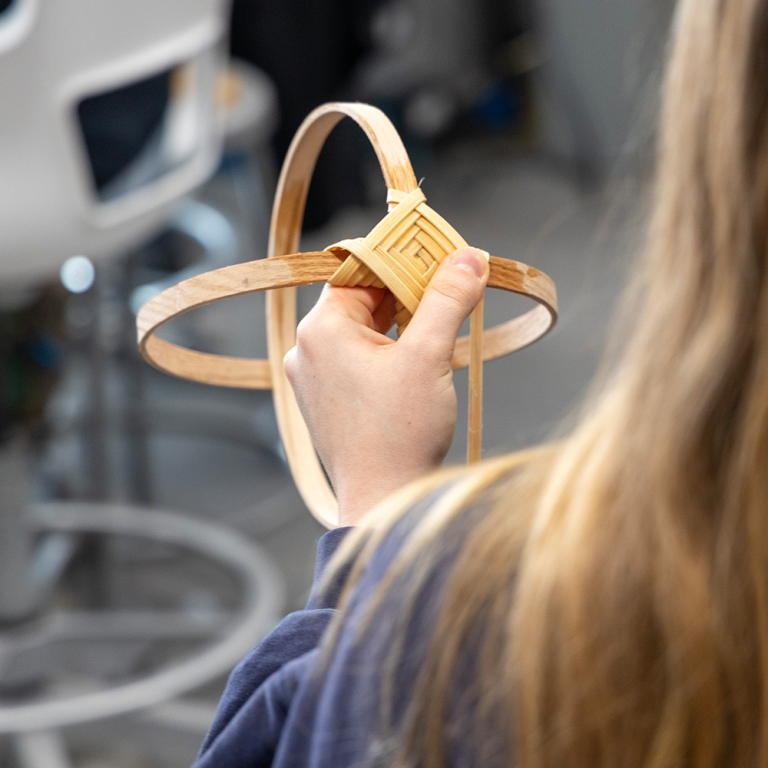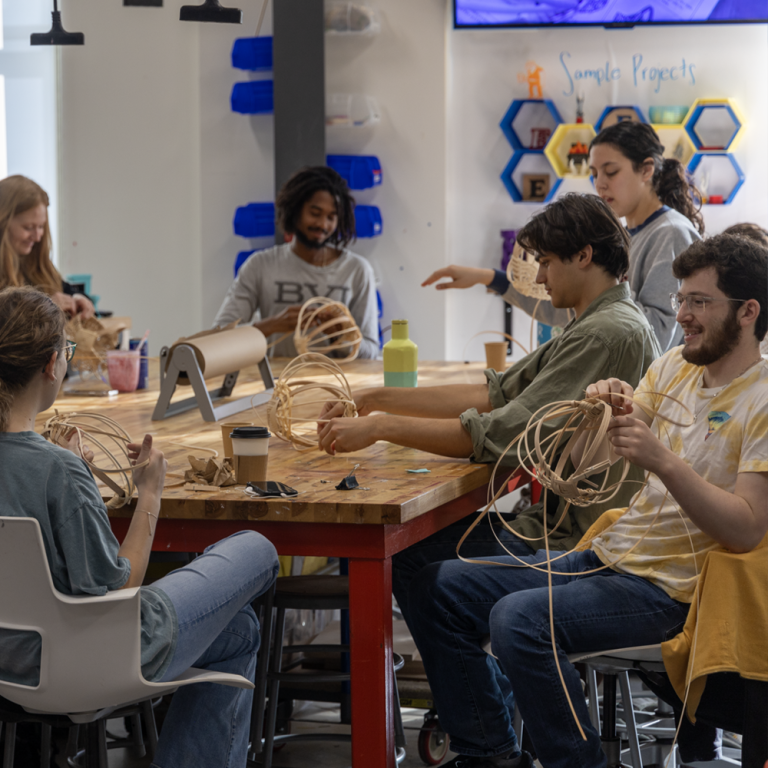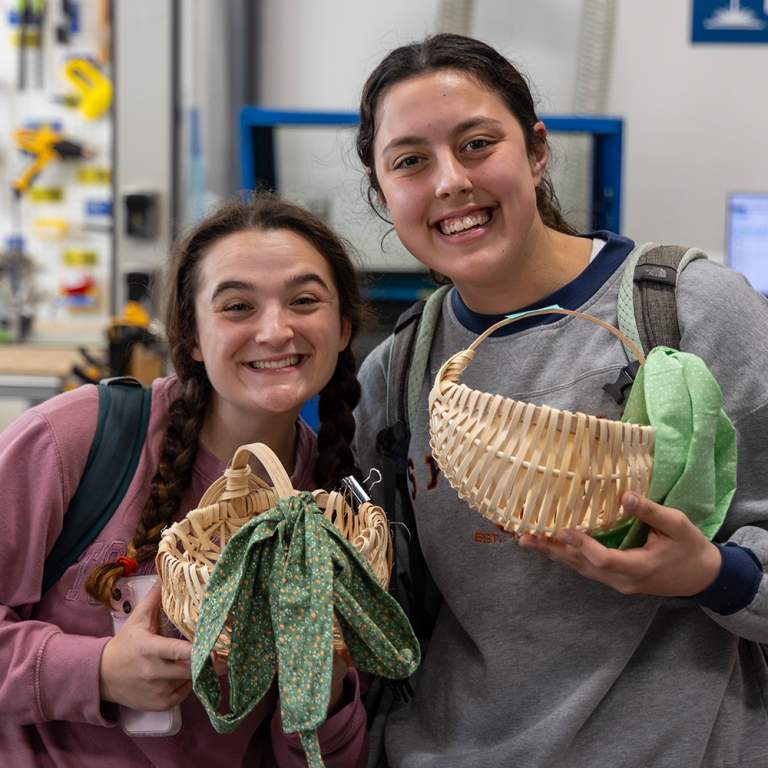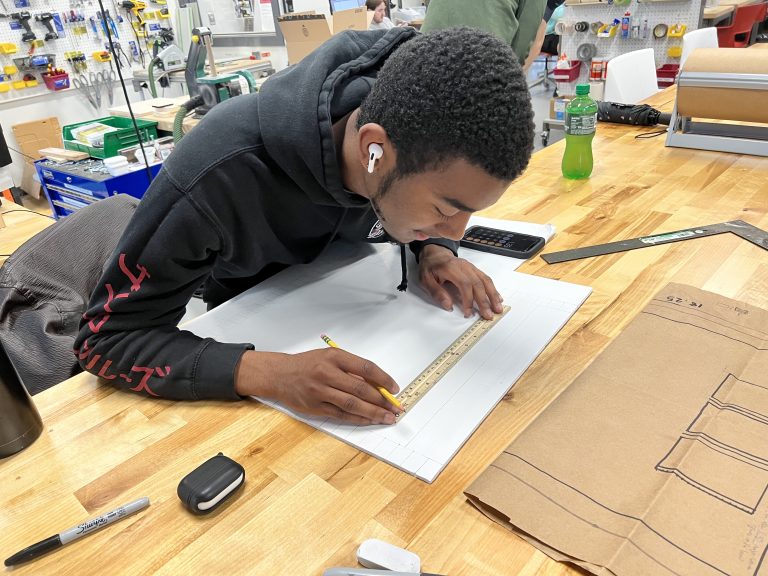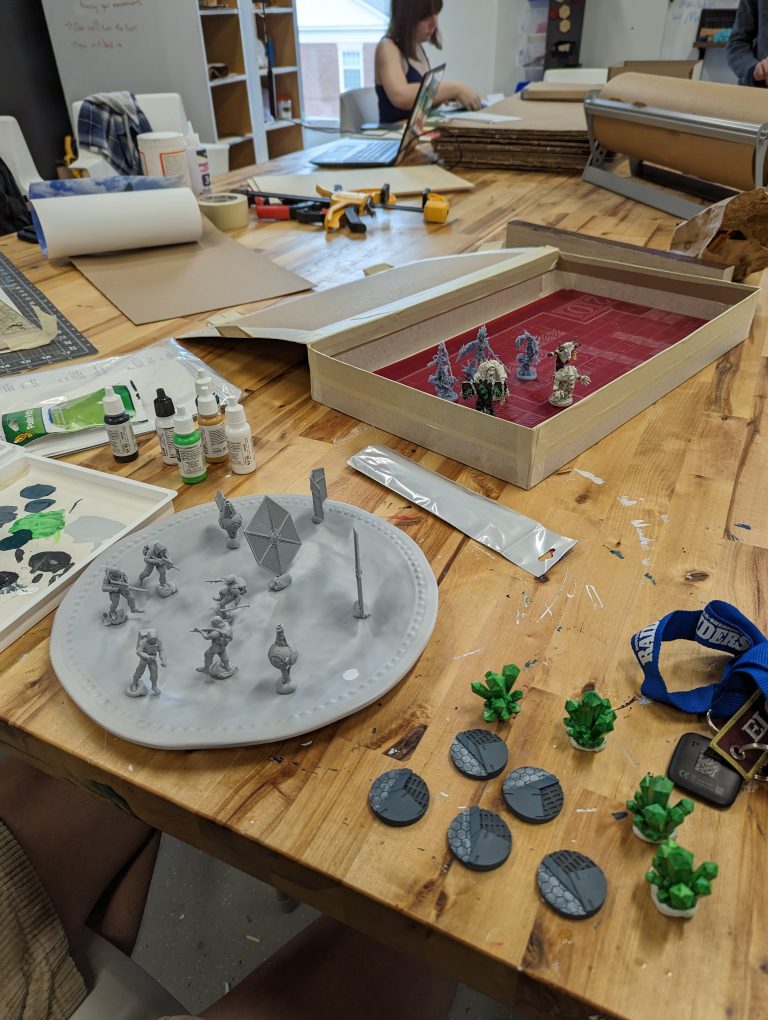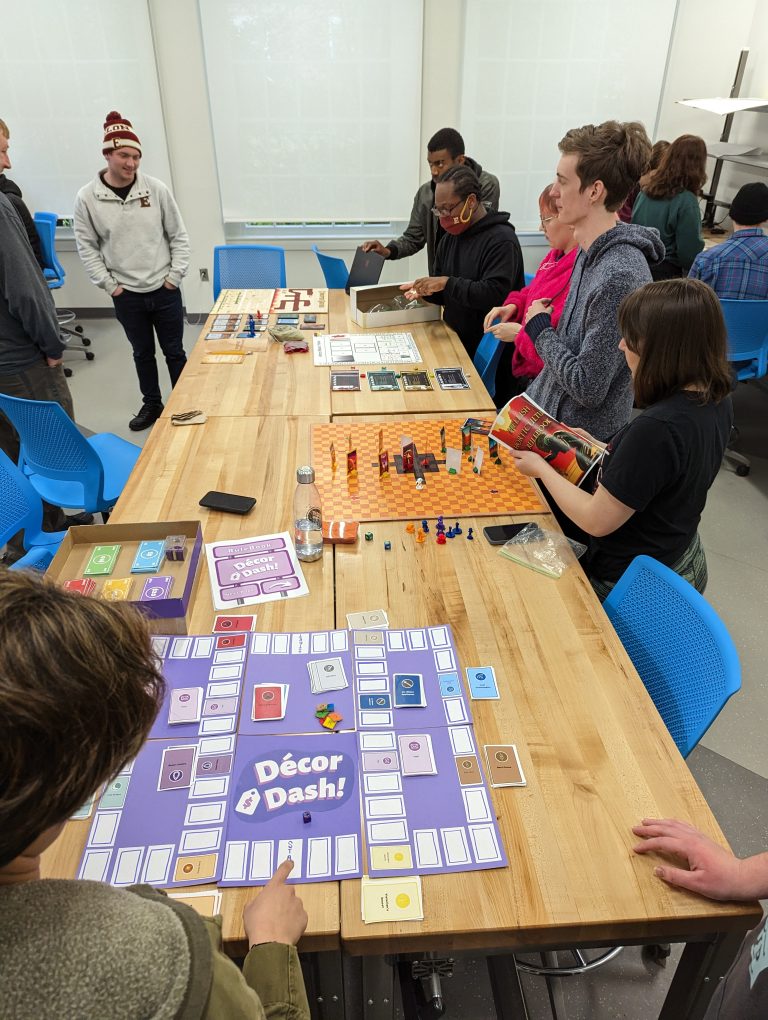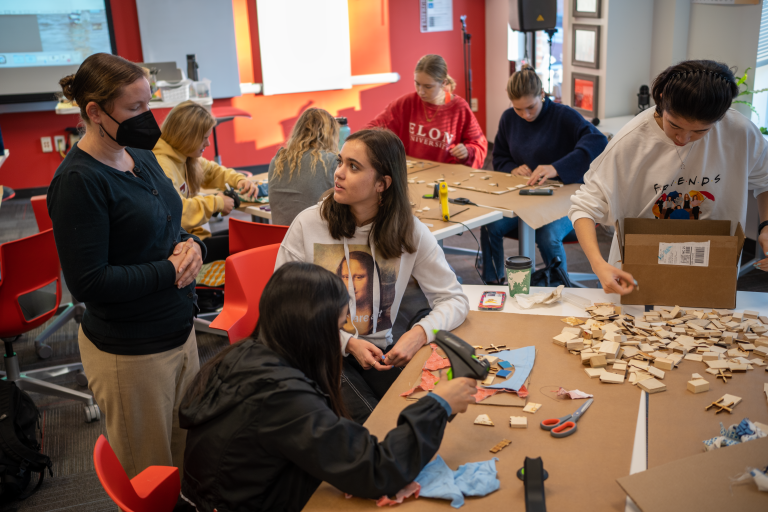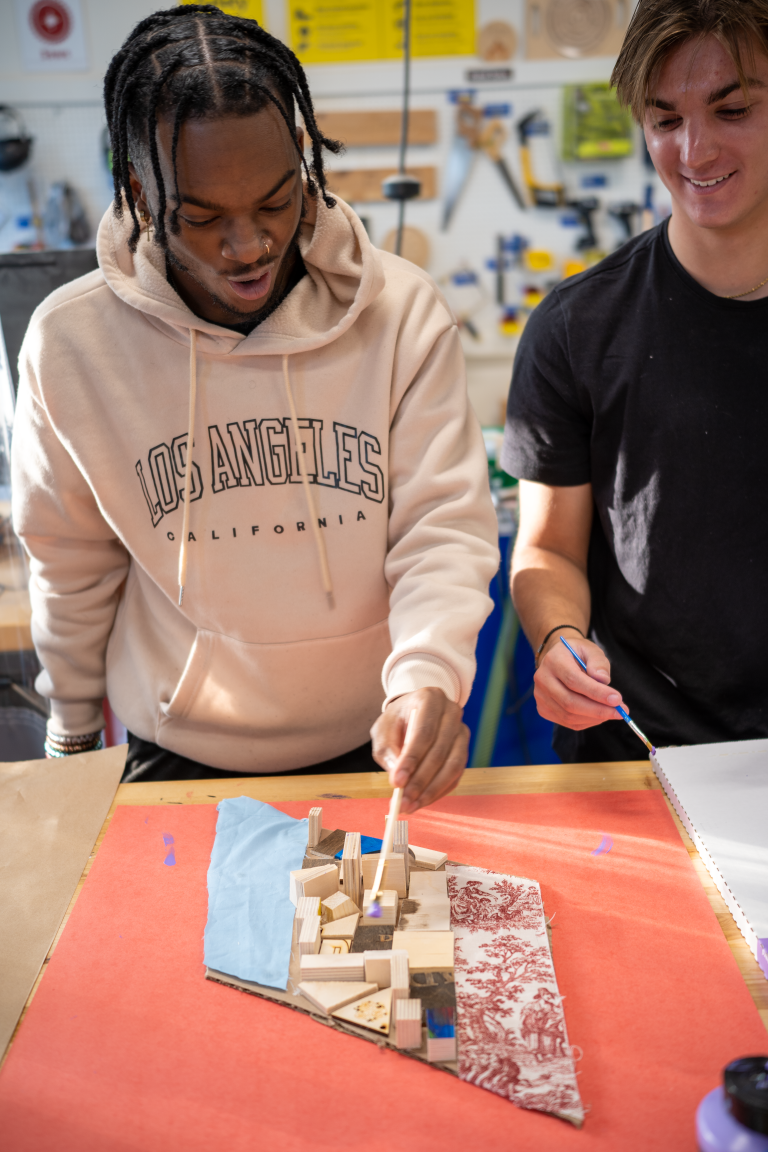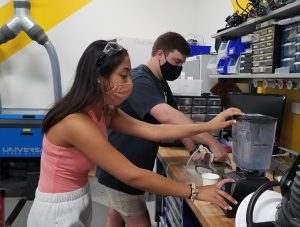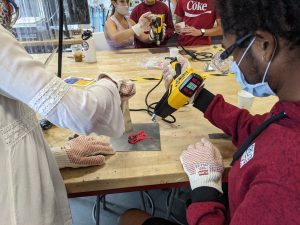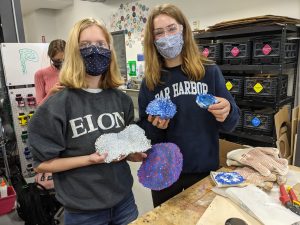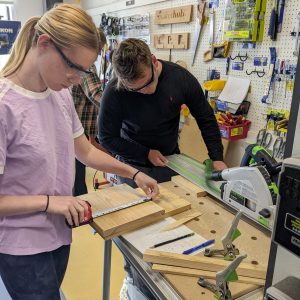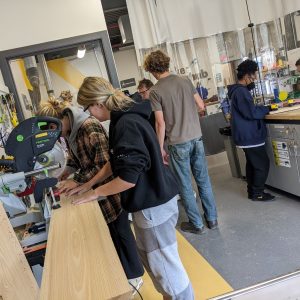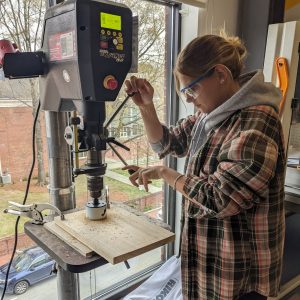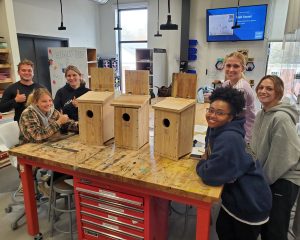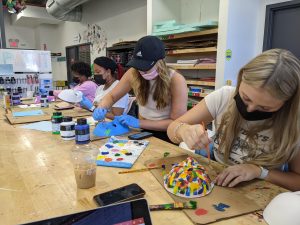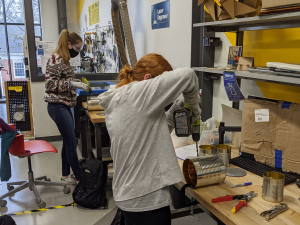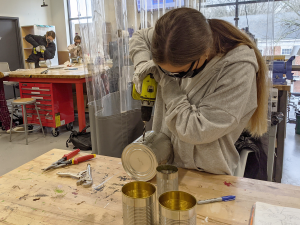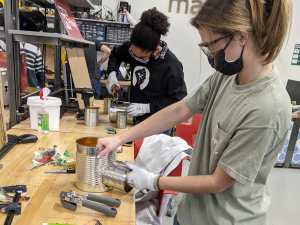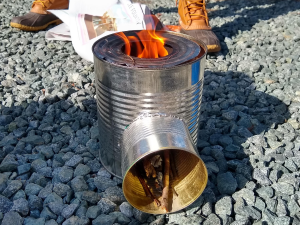Science & Math
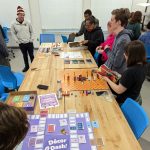
Game Design
3D printing, painting, and laser engraving custom board games
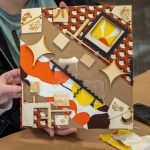
Humans & Nature
Using Maker Hub scraps as raw material for a personal project

Deep Time to the Anthropocene
Making new projects from plastic waste
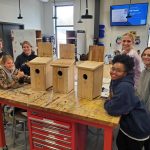
Sustainable Food Production
Making owl boxes to control pests at Loy Farm
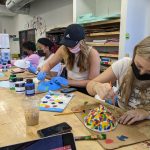
Healthcare Relationships
Personalizing paper masks to reflect professional identity

Current Issues in Environmental Studies
Making rocket stoves
 Art through a Mathematical Lens
Art through a Mathematical Lens
3D printing, art, and math
COR 3702: Wild Food and Medicine
Instructors: Kelsey Bitting and Evan Small
Assignment Objective
In our Wild Food and Medicine course, we wanted students to have baskets to use on our foraging expeditions. We also wanted students to focus on slowing down and developing a relationship with the natural world around us, so we also wanted students to have this experience working with natural materials and seeing how we can collaborate with nature to meet our needs.
Deliverable
Students created small foraging baskets for future class expeditions (and beyond)!
Why the Hub?
Tapping into our creativity is key to shifting the lenses through which we view nature, including food and medicine. Being at the Hub helps our students reconnect with their creative thinking abilities! We were so thankful that the Hub student staff worked with us to develop this project (one that they had never done before) and were such great teachers for this new skill.
Success? Encore?
It went great! Students described the basket-making process as quite challenging, so normalizing that challenge from the outset is something we’d work on next time. However, overcoming that challenge was something students frequently wrote about in their reflections and were especially proud of. Students were so excited to use their baskets on our foraging adventures and many shared that they were excited to continue doing so.
Tools
No special tools
Materials
Basketmaking rods and reeds
Game Design | GAM2100
Instructor: Pratheep Kumar Paranthaman
Assignment Objective
This assignment was part of the final project in the course, and for this, the students were required to work in teams of 2 -3 and develop a production-quality tabletop game. Students started the work for this game project around week 5 of the course and developed the project in multiple milestones by following an iterative development process. Prior to the production work in the Maker Hub, students developed multiple paper prototypes during class times and play tested those initial designs for game balance, play experience, and overall design consistency. The last 2 milestones were spent in the Maker Hub, where the students turned their paper prototypes into production-quality designs by using the tools available in the Maker Hub. I envisioned to provide an out-of-class and studio-style development experience for my students through this process. Additionally, I also wanted my students to get hands-on experience on 2 crucial points of game development (i.e.) working under constraints and managing the allocated resources.
Deliverable
The final deliverable was to produce a production-quality tabletop game. The definition of production quality in the context of this course is as follows
“A production-quality board game is a fully polished, playable, and balanced game system that can be directly distributed to customers either through online retail or displayed in a store.”
Why the Hub?
As specified in question 2 – “I envisioned providing an out-of-class and studio-style development experience for my students through this process. Additionally, I also wanted my students to get hands-on experience on 2 crucial points of game development (i.e.) working under constraints and managing the allocated resources.”
Also, the tools available in the MakerHub were supportive of the above-specified goal of this assignment.
Success? Encore?
I think the overall assignment went great, and my students thoroughly enjoyed learning about the tools in the Maker Hub and then incorporating those tools into their project work for this class. I’m planning to continue this activity in fall 2023 as well.
What advice would you give other faculty?
If your course consists of assignments that would involve design in any contexts, then Maker Hub would be a great source to integrate into course assignments. Specifically, Maker Hub will be suitable for assignments that involve prototyping, team building, and project planning. Also, I think it will be a wonderful out-of-class experience for students where we can simulate a workspace for students to collaborate and engage in hands on.
Tools
Students were required to complete the 3D Printing and Laser Engraving training offered in the Maker Hub outside of class time.
Materials
Cardstock, chipboard, paint, 3D prints, laminate sheet
Humans & Nature | ENS 1100
Instructor: Kelsey Bitting
Assignment Objective
This course interrogates the origins of cultural and economic models in which humans dominate and extract resources from the natural world and explores alternative models for healthier, more holistic, and sustainable ways we might coexist with the rest of the planet. In this context, the Maker Hub activity models the concept of a circular economy, in which waste products from one industrial process serve as the raw material for another. I hoped students would get a more concrete sense of how the circular economy concept could play out in the world around them and that they would be inspired to reconceptualize waste in a more ecosystem-inspired way.
Deliverable
Students in this activity made aesthetically-pleasing, interesting, or otherwise useful creations using scrap materials discarded by other Makers.
Why the Hub?
Incorporating tactile, creative activities in which students have choice and agency can help to spark student interest in the content. In this case, it also gave them a direct lived experience related to the concept of a circular economy, hopefully making the concept itself more memorable. Finally, I wanted students to envision the Maker Hub as a place they could go to decompress, find a creative outlet for their energy, and potentially explore artistic or entrepreneurial ideas that might inspire a more sustainable world.
Success? Encore?
Students engaged in the activity to varying degrees and with varying enthusiasm, but most seemed to enjoy the process. In the future, I’d like to repeat the activity and add an element of friendly competition, asking students to vote for their favorite creations by others and offering some small prizes for the winners. In setting up the rules of that competition, I’d look to the article we read on circular economy models to try to make the connection more explicit.
Tools
Hot glue guns, markers, paints
Materials
Scrap material from the maker hub, including oddly shaped pieces of fabric, acrylic, and wood. Cardboard backing.
Deep Time to the Anthropocene | HNR2340
Instructor: Amanda Chunco
Assignment Objective
My goal was to have students both learn more about plastic waste and think about the creative solutions that will be required to solve plastic pollution. This course is centered on sustainability and the idea that solutions to the big environmental problems that we face as a society will require interdisciplinary solutions. Going to the Maker Hub gave us a workable example of a process that creates waste (3D printing) and let us work collaboratively to re-use that waste to create a new, functional product. I hoped that students would see the connections between art and design and STEM and engage in thinking creatively about how to collaboratively work towards solving local environmental issues.
Deliverable
Students were working to create something out of the plastic waste from the 3D printers. The scope of their project was entirely determined by the group – their object could be anything they wanted as long as it used plastic waste. The goal was just to re-use something that was considered trash and make it into something useful or meaningful. Students created bracelets, rings, bowls, decorative plaques, and more.
- Students using a blender to grind up plastic scraps and using an iron to melt it.
- Students using a heat gun to melt plastic pellets.
- Students holding their flat sheets of melted plastic
Tools
We used a blender to grind up plastic into pellets. A heat press, iron, and heat gun to melt the pellets and press them into flat sheets. Some groups used the band saw and laser engraver to cut their sheets into shapes.
Materials
Scraps of 3D printed material (PLA plastic), high-temperature Teflon sheets
Why the Hub?
I had several reasons to choose the Maker Hub.
- I wanted students to see the importance of art and design in STEM disciplines.
- I wanted students to have a chance to think creatively about repurposing a ‘waste’ product.
- I wanted students to learn about the technologies available at the Maker Hub and to have a chance to do some hands-on projects with those tools as we talked in class about the role of technology as both the cause and the solution, of environmental problems.
Success? Encore?
This was one of the best activities I’ve done in my 10 years of teaching at Elon! Students had a great time making their projects and I thought they came up with some really creative things. Some students used Maker Hub resources in completing their final research project for the class. And, we had wonderful discussions about the design process, plastic pollution, and solving environmental issues that all stemmed from the time we spent in the Maker Hub. I will definitely be doing other projects with students at the Maker Hub in the future.
For faculty considering this, I would suggest having some clear learning goals in mind going into the activity, but being flexible and open to changing things up as the projects progress. I know my class needed more time than I initially planned, and I’m glad we just added an extra class at the Hub rather than trying to stay on a strict schedule. Also, Dan is a super valuable resource – he really helped me think about how to use the Hub to best meet my learning objectives.
Sustainable Food Production | ENS3110
Instructor: Jacob Rutz
- Students measuring and cutting planks of wood with the track saw.
- Students using the miter saw to cut planks of wood.
- A student using the drill press to make the hole in the screech owl box.
- Students around their finished owl boxes.
Assignment Objective
Building the owl boxes tied into our section on integrated pest management, a sustainability-minded approach to dealing with critters on the farm. The project itself was a physical manifestation of one technique, which is a form of biological management encouraging beneficial predators on the farm. By building a habitat for eastern screech owls, the class is helping minimize mammal predation on farm crops.
The goal for the class’s learning outcomes was to both reinforce pest management practices techniques as well as expose them to utilizing woodworking tools to build confidence and autonomy using tangible tools. Agricultural work is still largely a hands-on occupation and anytime we can physically do something to engage with the natural world in my classes, I’m going to use that opportunity.
Deliverable
The students were building an Audobon Society-designed eastern screech owl box house. The house will provide shelter for nesting birds in and around Loy Farm.
Why the Hub?
The Maker Hub provided an ideal space for students to utilize a wide variety of woodworking tools with thoughtful training and oversight. The Hub is a very welcoming, clean, and safe space that helps new makers jump right in with minimal barriers to entry so that we can start working on our projects as soon as possible, while still utilizing best practices.
Success? Encore?
The project was a success! We built three boxes that will be mounted across Loy Farm and hopefully have owl inhabitants in the near future. The students enjoyed this lab as a shake-up to our usual labs and as a way to feel really accomplished in a three-hour period.
Advice to other faculty would be to first practice the project yourself as space and movement around the floor can lead to unforeseen bottlenecks or challenges. Having a clear, visual plan (thanks Audubon Society) for student projects really improves the time spent in the space.
Tools
We used a miter saw, track saw, drill press, and hand drills. Students were required to complete the Maker Hub’s saws training on their own time before the class session. With the training out of the way, we were able to spend the lab session building the boxes.
Materials
Planks of cedar, hinges, outdoor screws
Healthcare Relationships | NRS2000A
Instructor: Cyra Kussman and Elizabeth Van Horn
First-year students in the School of Health Sciences created a personalized paper mask to reflect their professional identity. Students were encouraged to work on their masks on their own time and at work nights, hosted at the Maker Hub. Professor’s Kussman and Van Horn brought their nursing students to the Maker Hub during class so they had focused time to work. Students painted, cut out stickers on the vinyl cutter, cut out symbols on the laser engraver, and more. Learn more about this initiative on Today @ Elon.
- Students painting and using the vinyl cutter in the Maker Hub.
- Students painting their masks in the Maker Hub
Current Issues in Environmental Studies | ENS101
Instructor: Jacob Rutz
Assignment Objective
The paragraph below was the little primer I wrote for them: How we cook says a lot about our socioeconomic status, the country we live in, the natural resources available to us, and predict our health outcomes. In this independent project, you will be exploring the intersection of many of these topics through the lens of the stove itself, focusing on a developing world technology, rocket stoves. This project is a design-build project, meaning you are in charge of making the design and building your rocket stove; there are no set instructions as in typical labs. Instead, you will learn alongside your classmates design principles while actively implementing them into your own design.
Deliverable
A rudimentary “rocket stove” – a small, wood-powered stove built from recycled materials and some basic insulation – that was able to boil a pot of water using nothing but fallen twigs and sticks (and a lighter and a bit of paper to get it going).
- Students drilling holes into their tin cans.
- A student making a pilot hole in order to use tin snips to cut a hole in the side of the can.
- A student fitting a smaller can into the larger can in order to feed sticks into the stove.
- Current Issues in Environmental Studies – Jacob Rutz: A rocket stove made from upcycled cans burning twigs.
Tools
Dremel, power drills and various bits, tin snips, pliers, files, and of course good safety equipment.
Materials
Recycled cans from Elon Dining (the majority of the build), high-heat resistant tape, and an insulation material (perlite, sand, gravel, or air)
Why the Hub?
There really was no other way for the students to build these stoves without the Hub! It was an essential tool for this project and a safe and exciting one at that.
Success? Encore?
Definitely a success in terms of student engagement, doing something outside their comfort zone, and a little unique. I love hands-on projects, and I know this one was a challenge for my students in terms of both doing the work and integrating the concepts learned in lecture. This was the first time I did this, I’d like to do it again and do more to ensure the in-class component is better applied to the design process.
Art through a Mathematical Lens | COR 435
Instructor: Crista Arangala
Assignment objective
In the first few days of the term, students focused on dimensionality and the concept of infinity. This project allowed them to create a way of displaying their understanding.
Deliverable
Students learned about 2 artists, MC Escher and Yayoi Kusama, and read a book entitled Flatland by E. Abbott. Flatland is a 2D world and the main character (Mr. Square) describes his discovery of multiple dimensions. For this project students had to create an art piece (with description) depicting Mr. Squares discovery through Escher or Kusama’s artistic lens.
Tools
3D printers and other tools based on the student’s piece.
Materials
Some made mirror boxes, some painted their 3D prints.
Why the Hub?
I feel like exposure to the Makerspace, in general, is important. I believe each student has a creative side that may just need to be inspired. Many students had never been to the Maker Hub (and they were all juniors and seniors) and they were very excited to use the tools – particularly the 3D printer.
Success? Encore?
Students really enjoyed this project and many of them had never been to the Maker Hub. The project really tapped into their creative spirit and nicely tied to our in-class discussions. Absolutely, would use the makerspace for more projects in the future.
